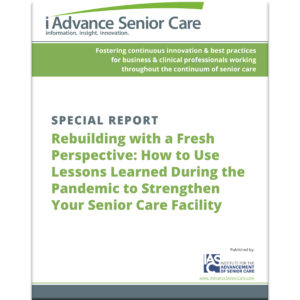New Report Identifies Key Lessons for Nursing Homes From the Pandemic
In late January, the Office of Inspector General (OIG), in the Department of Health and Human Services, released the second report in a series of three reports examining nursing home experiences in 2020. Jenell Clarke-Whyte, team leader for the study, explains the origin of the reports. “We embarked on the series when it became clear that nursing home residents were particularly vulnerable to COVID-19,” she says.
The first report in the series focused primarily on residents, while this second report shifts the focus to nursing homes, themselves. “We found that 1,300 nursing homes had extremely high infection rates, with about 75% of their Medicare beneficiaries diagnosed with COVID-19 during the first year,” Clarke-Whyte says. The report examines the characteristics of those nursing homes, while the third report, she says, “will describe the specific challenges that nursing homes faced during the pandemic, and their strategies.”
Key Findings From the Report

Jenell Clarke-Whyte, Office of Inspector General (Department of Health and Human Services)
The OIG used Medicare claims data to review which nursing homes had Medicare beneficiaries who were diagnosed with COVID-19. The team of evaluators reviewed data from 15,086 nursing homes nationwide, then identified the homes that had extremely high infection rates during the spring and fall 2020 surges. “Extremely high identification rates” were defined as nursing homes in which three-quarters or more of Medicare beneficiaries were diagnosed with COVID-19 or likely COVID-19 during the surge.
The report data revealed that more than 1,300 nursing homes had extremely high infection rates, and those nursing homes also experienced “dramatic increases in overall mortality (not limited to deaths of beneficiaries who had or likely had COVID-19).” Those nursing homes experienced an average overall mortality rate that neared 20% during the surges, which was approximately double the mortality rate that other nursing homes experienced during the same periods. In 2019, these nursing homes had an average mortality rate of 6%.
Of the nursing homes with extremely high infection rates, a disproportionate percentage were for-profit nursing homes. The report also found that just because a nursing home was located in a county with high COVID-19 transmission, the nursing home, itself, didn’t necessarily experience high infection rates. The majority of the nursing homes with extremely high infection rates met or exceeded Medicare’s minimum nursing hours requirements, and the survey didn’t identify deficiencies in infection control for most of these nursing homes.
Recommendations for CMS
The report findings indicate that nursing homes were largely unprepared for the COVID-19 pandemic, and they were not able to control the virus’ spread. It is evident that significant change is needed to prepare nursing homes for future pandemics and public health emergencies.
“Based on the findings, we made three recommendations,” explains Clarke-Whyte. Those recommendations focus on infection control, staffing, and oversight. “There’s a need for significant improvement, and each recommendation we made provides a path to improvement. It’s no doubt the pandemic was a call to action. We are committed to working with CMS to promote the implementation of the recommendations,” she says.
Key Lessons for Nursing Homes
While the third report in this series will focus more on the specific challenges that nursing homes faced and the strategies they used during the pandemic, this second report carries important lessons for nursing homes, too.
“I think there’s a lot that individual nursing homes can learn from the data brief,” says Clarke-Whyte. “A nursing home does not have to be overrun with infections, even if it’s located in a county with high transmission. We found that high transmission in a county didn’t always lead to nursing homes in the county reaching extremely high infection rates,” she explains.
Meeting minimum nursing hour requirements may also not be enough to fully protect residents. “We found that the majority of nursing homes with extremely high infection rates reported nursing hours that met or exceeded requirements,” notes Clarke-Whyte.
Lastly, most nursing homes with extremely high infection rates weren’t deficient in their infection control procedures. “From what we found, nursing homes were not prepared for the health emergency the pandemic created,” she says. “They weren’t able to stem the devastation, so need for improvement is great and clear.”

Paige Cerulli is a contributing writer to i Advance Senior Care.
Related Articles
Topics: Administration , Featured Articles , Infection control , Medicare/Medicaid , Regulatory Compliance , Resident Care , Staffing








